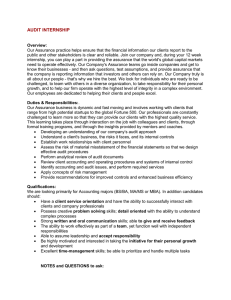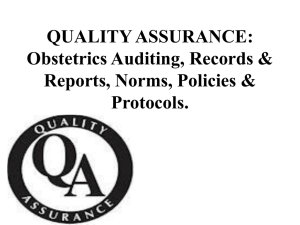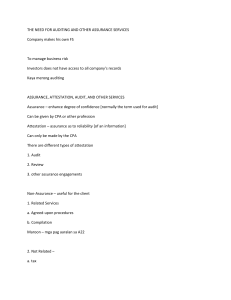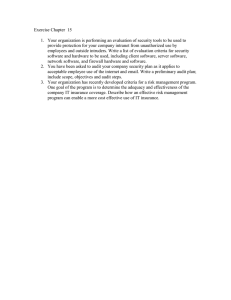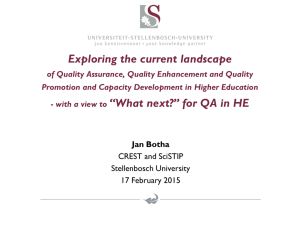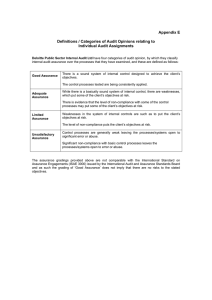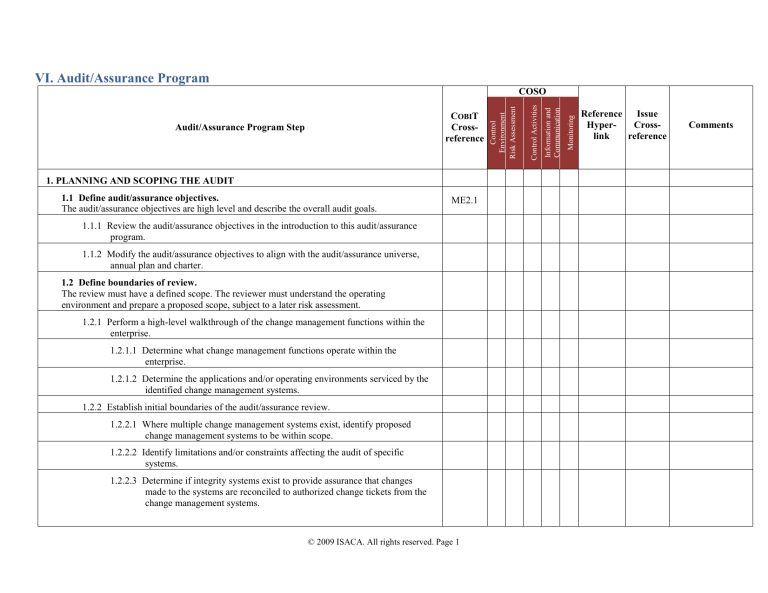
VI. Audit/Assurance Program 1. PLANNING AND SCOPING THE AUDIT 1.1 Define audit/assurance objectives. The audit/assurance objectives are high level and describe the overall audit goals. ME2.1 1.1.1 Review the audit/assurance objectives in the introduction to this audit/assurance program. 1.1.2 Modify the audit/assurance objectives to align with the audit/assurance universe, annual plan and charter. 1.2 Define boundaries of review. The review must have a defined scope. The reviewer must understand the operating environment and prepare a proposed scope, subject to a later risk assessment. 1.2.1 Perform a high-level walkthrough of the change management functions within the enterprise. 1.2.1.1 Determine what change management functions operate within the enterprise. 1.2.1.2 Determine the applications and/or operating environments serviced by the identified change management systems. 1.2.2 Establish initial boundaries of the audit/assurance review. 1.2.2.1 Where multiple change management systems exist, identify proposed change management systems to be within scope. 1.2.2.2 Identify limitations and/or constraints affecting the audit of specific systems. 1.2.2.3 Determine if integrity systems exist to provide assurance that changes made to the systems are reconciled to authorized change tickets from the change management systems. © 2009 ISACA. All rights reserved. Page 1 Monitoring Information and Communication Control Activities COBIT Crossreference Audit/Assurance Program Step Control Environment Risk Assessment COSO Reference Issue HyperCrosslink reference Comments 1.3 Define assurance. The review requires two sources of standards. The corporate standards, as defined in policy and procedure documentation, establish the corporate expectations. At minimum, corporate standards should be implemented. The second source, a good-practice reference, establishes industry standards. Enhancements should be proposed to address gaps between the two. 1.3.1 Obtain company change management standards, if they exist. 1.3.2 Determine if COBIT or the IT Infrastructure Library (ITIL) or both will be used as a good-practice reference. 1.4 Identify and document risks. The risk assessment is necessary to evaluate where audit resources should be focused. In most enterprises, audit resources are not available for all processes. The risk-based approach ensures utilization of audit resources in the most effective manner. 1.4.1 For the applications and systems identified as potentially being in scope: 1.4.1.1 Identify the change control risks associated with the applications and operating environment. 1.4.1.2 Assess the business risk of each operating environment, based on the applications serviced. 1.4.2 Based on the risk assessment, identify changes to the scope. 1.4.3 Discuss the risks with IT, the business and operational audit management, and adjust the risk assessment. 1.4.4 Based on the risk assessment, revise the scope. 1.5 Define the change process. The initial audit approach is based on the reviewer’s understanding of the operating environment and associated risks. As further research and analysis are performed, changes to the scope and approach will result. 1.5.1 Identify the senior IT assurance resource responsible for the review. © 2009 ISACA. All rights reserved. Page 2 Monitoring Information and Communication Control Activities COBIT Crossreference Audit/Assurance Program Step Control Environment Risk Assessment COSO Reference Issue HyperCrosslink reference Comments Control Activities Information and Communication Monitoring COBIT Crossreference Audit/Assurance Program Step Control Environment Risk Assessment COSO X X X 1.5.2 Establish the process for suggesting and implementing changes to the audit/assurance program, and note the authorizations required. 1.6 Define assignment success. The success factors need to be identified. Communication among the IT audit/assurance team, other assurance teams and the enterprise is essential. 1.6.1 Identify the drivers for a successful review (this should exist in the assurance function’s standards and procedures). 1.6.2 Communicate success attributes to the process owner or stakeholder, and obtain agreement. 1.7 Define audit/assurance resources required. The resources required are defined in the introduction to this audit/assurance program. 1.7.1 Determine audit/assurance skills necessary for review. 1.7.2 Estimate the total resources (hours) and time frame (start and end dates) required for review. 1.8 Define deliverables. The deliverable is not limited to the final report. Communication between the audit/assurance teams and the process owner is essential to assignment success. 1.8.1 Determine the interim deliverables, including initial findings, status reports, draft reports, due dates for responses and the final report. 1.9 Communications The audit/assurance process is clearly communicated to the customer/client. 1.9.1 Conduct an opening conference to discuss the review objectives with the executive responsible for operating systems and infrastructure. 2. UNDERSTANDING SUPPORTING INFRASTRUCTURE 2.1 Incident management system The incident management system (often referred to as the problem tracking system) feeds the change management system with requests resulting from system interruptions or user- DS10.4 © 2009 ISACA. All rights reserved. Page 3 Reference Issue HyperCrosslink reference Comments Monitoring Information and Communication Control Activities COBIT Crossreference Audit/Assurance Program Step Control Environment Risk Assessment COSO discovered issues. 2.1.1 If an audit of the incident management system has been performed previously, obtain the work papers from that audit. 2.1.1.1 Review the previous findings and gain an understanding of the incident management system and control issues that may affect the change management process. 2.1.2 If a prior audit has not been performed or the environment has changed significantly, obtain an understanding of the feeds from the incident management system. 2.1.2.1 Determine if the feed is automated, directly interfacing with the change management system. 2.1.2.2 Based on the review, determine if further investigation is required or if the scope of change management will assume validity of the incident/problem ticket. 2.2 Program library management The program library management process controls access to and documentation of the program source code and configuration files. AI3.2 AI7.8 DS5.7 X X AI3.2 AI7.8 DS5.7 X X 2.2.1 If prior assurance work has included a review of the program library management system, obtain and review the work papers and follow up on the findings. 2.2.2 If no prior assurance work has been performed, obtain documentation and descriptions of the various program library management systems in use within the scope of the application/system software included in the audit. 2.3 Executable library security The executable libraries include the compiled versions of the programs. This code is used by the computer to process the data. The executable library will have similar controls as the program library; however, it will have the added requirement that the program and executable libraries must be synchronized (the program stored in the program library must, when compiled, generate the same executable as the program stored in the executable library). © 2009 ISACA. All rights reserved. Page 4 Reference Issue HyperCrosslink reference Comments Monitoring Information and Communication Control Activities COBIT Crossreference Audit/Assurance Program Step Control Environment Risk Assessment COSO Reference Issue HyperCrosslink reference 2.3.1 Obtain the documentation describing how executable programs are stored on the systems within the scope (operating systems store the programs differently). 2.3.2 If an outside vendor provides patches or executable programs to the enterprise without providing the source, determine the distribution process for these programs. 2.4 Distributed executable distribution system Similar to the executable library, in a distributed operating environment, the programs are compiled centrally, but the executables are distributed to the various processing locations. 1. AI3.2 AI7.8 DS5.7 X 2. 2.4.1 Obtain the documentation describing how distributed systems receive the executable programs from the central programming location. 2.5 Systems development methodology This methodology addresses the planning, design, development and testing of new and updated software. Since systems requests resulting from the systems development methodology are within scope, it is necessary to obtain an understanding of the request process. 3. PO8.3 2.5.1 Obtain the documentation for the systems development process, including systems requests, evaluation of the project, risk assessment, resource allocation, testing and program quality assurance. 2.5.2 Obtain the documentation for change management relating to configuration management, including change requests, evaluation of the effect of the change on production systems, risk assessment, resource allocation, testing and system quality assurance. 3. IDENTIFY CHANGE NEED Audit/assurance objective: Only changes that are authorized, evaluated and prioritized and the resources required should enter the change process. 3.1 Control: Management classifies, reviews and approves change requests. This control ensures that management has considered and approved the changes in the queue. 3.1.1 Obtain the enterprise’s standards, procedures and guidelines for identifying, classifying and approving change requests. © 2009 ISACA. All rights reserved. Page 5 X X X X X 4. 5. 6. Comments 3.1.1.1 Information should be obtained by interviews, observation and reviewing documentation. 3.1.1.1.1 Determine if a process exists to classify change requests as an infrastructure or application change. 3.1.1.1.2 Determine if a process exists to perform a risk assessment focused on the impact of the change on other systems or applications. 3.1.1.1.3 Determine if there is a process to perform an impact analysis on changes to determine the effect the change would have on the business process’s integrity and availability. 3.1.1.1.4 Determine if there is a process for performing an analysis of any compliance issues that would be affected by the change request. 3.1.1.1.5 Determine if a resource budget is assigned to each change request. 3.1.1.1.6 Determine if a list exists of appropriate change requesters for each application. 3.1.1.1.7 Verify that the appropriate approvers within IT operations, IT systems development and the business owner have approved the change and their approval is documented. 3.1.1.1.8 Determine if the change requests are subject to prioritization. 3.1.1.1.8.1 If prioritization is performed, determine if appropriate members of management regularly authorize the priority. 3.1.2 Test objective: To verify compliance with the review and prioritization process 3.1.2.1 Using the move ticket, obtain a population of requested changes. 3.1.2.1.1 When making the selection, select representative samples resulting from emergency requests, systems requests and problem tickets. © 2009 ISACA. All rights reserved. Page 6 Monitoring Information and Communication Control Activities COBIT Crossreference Audit/Assurance Program Step Control Environment Risk Assessment COSO Reference Issue HyperCrosslink reference 7. Comments 3.1.2.1.2 Stratify the selection of tickets to include a greater sample of higher-risk application/software changes, but also include a lesser number of medium- and low-risk changes. 3.1.2.1.3 For each selected ticket: 3.1.2.1.3.1 Trace the move request to the originating request (systems request, problem ticket or emergency request [if different]). 3.1.2.1.3.2 Determine if each ticket was classified as an infrastructure or application change. 3.1.2.1.3.3 Determine if there was a risk assessment performed for impact on other systems or applications. 3.1.2.1.3.4 Determine if an impact analysis was performed to determine the effect the change would have on the enterprise. 3.1.2.1.3.5 Determine if there was an analysis of any compliance issues that would be affected by the change request. 3.1.2.1.3.6 Determine if a resource budget had been assigned to the change request. 3.1.2.1.3.7 Determine if the appropriate approvers within IT operations, IT systems development and the business owner documented their approval of the change. 3.1.2.1.3.8 Determine if the change request had been subject to prioritization. 3.1.2.1.3.8.1 If prioritization had been granted, determine if appropriate management had authorized the priority. © 2009 ISACA. All rights reserved. Page 7 Monitoring Information and Communication Control Activities COBIT Crossreference Audit/Assurance Program Step Control Environment Risk Assessment COSO Reference Issue HyperCrosslink reference Comments Monitoring Information and Communication Control Activities COBIT Crossreference Audit/Assurance Program Step Control Environment Risk Assessment COSO 4. PRODUCTION LIBRARY MANAGEMENT Audit/assurance objective: Production libraries should be secure, allowing only authorized personnel to access the production libraries. Management must provide oversight of access to libraries, good-practice separation of duties, and synchronization of source and executable libraries. 4.1 Production source library controls The production source libraries contain the source language and configuration for the production programs. Access needs to be limited and monitoring processes need to be in place to effectively oversee change activities affecting the source libraries. 4.2 Control: Access to production source is limited on a need-to-know basis. Programmers are limited to READ access; only change management staff members are assigned WRITE access (except for emergency changes, described in Step 6). AI3.2 AI7.8 DS5.7 4.2.1 Through interviews, observation and review of documentation, determine the controls limiting access to the production source libraries. 4.2.1.1 Determine if there is a separation-of-duties table identifying the access levels and to whom they are assigned. 4.2.1.2 Verify that ID access logs, including date and time stamps, are maintained and reviewed on a regular basis. 4.2.1.3 Determine if access control lists are reviewed and updated regularly. 4.2.1.4 Test objective: To verify that access to the production source libraries is provided on a need-to-know basis 4.2.1.4.1 Obtain the access control list for production source library. 4.2.1.4.2 Review the list and identify any personnel not in the change management with WRITE access to the library. 4.2.1.4.3 Obtain the access log and identify unauthorized or suspect access to production library. 4.2.1.4.4 Verify documented management review of the access control list and unusual activity logs. Ensure periodic review. © 2009 ISACA. All rights reserved. Page 8 X X Reference Issue HyperCrosslink reference Comments 4.3 Control: Production source libraries maintain version control, which provides a history of all modifications and the ability to roll back the source to a previous version if the new version is not functioning properly. Monitoring Information and Communication Control Activities COBIT Crossreference Audit/Assurance Program Step Control Environment Risk Assessment COSO AI3.2 AI7.8 DS5.7 X X AI3.2 AI7.8 DS5.7 X X 4.3.1 Through interviews, observation and review of documentation, determine how version control operates and if it can be overridden. 4.3.2 Through interviews, observation and review of documentation, determine if the functionality exists to roll back an update program to its previous version. 4.4 Production executable library controls The production executable libraries contain the computer code to process the programs. Access needs to be limited and monitoring processes need to be in place to effectively oversee change activities affecting the executable libraries. 4.5 Control: Access to production executable libraries is limited to a need-to-know basis. Programmers are limited to READ access; only change management staff members are assigned WRITE access (except for emergency changes described in Step 6). 4.5.1 Through interviews, observation and review of documentation, determine the controls limiting access to the production executable libraries. 4.5.1.1 Determine if there is a separation-of-duties table identifying the access levels and to whom they are assigned. 4.5.1.2 Determine if ID access logs, including date and time stamps, are maintained and reviewed on a regular basis. 4.5.1.3 Determine if access control lists are reviewed and updated regularly. 4.5.1.4 Test objective: To verify that access to the production executable libraries is provided on a need-to-know basis 4.5.1.4.1 Based on risk, select the production executable libraries to be tested. 4.5.1.4.2 Obtain the access control list for production executable libraries. 4.5.1.4.2.1 Review the list and identify any personnel not in the change management with WRITE access to the libraries. © 2009 ISACA. All rights reserved. Page 9 Reference Issue HyperCrosslink reference Comments Monitoring Information and Communication Control Activities COBIT Crossreference Audit/Assurance Program Step Control Environment Risk Assessment COSO 4.5.1.4.2.2 Obtain the access log and identify unauthorized or suspect access to production libraries. 4.5.1.4.2.3 Verify documented management review of the access control list and unusual activity logs. 4.6 Control: Production executable libraries maintain version control, which provides a history of all modifications and the ability to roll back the executable to a previous version if the new version is not functioning properly. AI7.5 DS9.1 X X AI7.8 X X 4.6.1 Through interviews, observation and review of documentation, determine how version control operates and if version control can be overridden. 4.6.2 Through interviews, observation and review of documentation, determine if the functionality exists to roll back an update program to its previous version. 4.7 Control: Changes to the production executable libraries of distributed systems utilize a scheduled transmission and acknowledgment process to ensure accurate, complete and timely transmission of changes. 4.7.1 Through interviews, observation and review of documentation, determine what control techniques are utilized to ensure complete and accurate transmission of program changes. 4.7.2 Test objective: To verify the accuracy of distribution of executables to remote processors 4.7.2.1 Select a sample of executables. 4.7.2.2 Determine the size, date and time of the executables to be distributed as they reside in the master executable library. 4.7.2.3 For the selected executable, determine the date and time transmitted and the size of the file at the distributed computer. 4.7.2.4 Evaluate the timeliness and completeness of the distribution. © 2009 ISACA. All rights reserved. Page 10 Reference Issue HyperCrosslink reference Comments Control Activities Information and Communication Monitoring COBIT Crossreference Audit/Assurance Program Step Control Environment Risk Assessment COSO X X X 5. MOVE TO PRODUCTION Audit/assurance objective: The move to the production process should be controlled and documented. Access should be limited to authorized change management personnel. Only authorized changes should have been made to production programs, and the move process should ensure synchronization of the source and executable libraries. 5.1 Control: Program changes require sign-off by the appropriate stakeholders prior to being moved into production. AI6.2 AI6.5 5.1.1 Determine if the sign-off process, prior to a change moving into production, includes the following: 5.1.1.1 The programming function indicates completion of testing, quality assurance and documentation. 5.1.1.2 Users indicate satisfactory acceptance test, approval and knowledge of implementation date. 5.1.1.3 IT operations indicates acceptance of documentation, scheduling changes, backup changes, run-time changes, etc. 5.1.1.4 Information security indicates acceptance of information security changes. 5.1.1.5 Documentation (user, IT operations, backup/recovery business continuity plan) is approved. 5.1.1.6 Test objective: To verify the sign-off process to ensure that all signoffs were completed before the move to production and the appropriate personnel approved the move 5.1.1.6.1 Obtain a sample of routine move-to-production tickets for applications and software changes in scope. 5.1.1.6.2 For each move ticket, verify timely approvals by: 5.1.1.6.2.1 The programming function indicates completion of testing, quality assurance and documentation. © 2009 ISACA. All rights reserved. Page 11 Reference Issue HyperCrosslink reference Comments Monitoring Information and Communication Control Activities COBIT Crossreference Audit/Assurance Program Step Control Environment Risk Assessment COSO 5.1.1.6.2.2 Users indicate satisfactory acceptance test, approval and knowledge of implementation date. 5.1.1.6.2.3 IT operations indicates acceptance of documentation, scheduling changes, backup changes, run-time changes, etc. 5.1.1.6.2.4 Information security indicates acceptance of information security changes. 5.1.1.6.2.5 Documentation indicates satisfactory reviews by users, IT operations, backup/recovery business continuity plan. 5.2 Control: Change management software is used to control the change process. AI6.1 5.2.1 Through interviews, observation and review of documentation, determine the automated change management process. 5.2.1.1 Walk through the process of entering a move ticket, approving the ticket, compiling the program and moving it into production. 5.2.1.2 Determine the controls to identify and authenticate the approver’s authority to move a program into production. 5.2.1.3 Determine the available logs and reports generated by the change management system to trace and research program moves into production. 5.2.1.4 Determine if there are “back doors” that allow bypassing of the change management software system. 5.2.1.5 Determine if logs and reports generated by the change management system are reviewed by management and if such reviews are formally documented. 5.2.2 Test objective: To verify that the change management software and user controls are effective © 2009 ISACA. All rights reserved. Page 12 X X Reference Issue HyperCrosslink reference Comments Monitoring Information and Communication Control Activities COBIT Crossreference Audit/Assurance Program Step Control Environment Risk Assessment COSO 5.2.2.1 Based on the reviewer’s understanding of the automated move process, identify control points to test (consider automated authorization, monitoring, logging capabilities, independent recompilation of programs, etc.). 5.2.2.2 Select several change tickets. 5.2.2.3 Focusing on the control points identified in step 5.2.2.1, follow the selected change tickets through the process, verifying compliance with identified controls. 5.3 Control: Manual controls throughout the program move process prevent unauthorized moves to production. AI3.2 AI7.8 DS5.7 5.3.1 Document the process of moving the program from the test to the production environment. 5.3.2 Document the process of independently recompiling the programs by someone other than the programmer, and placing the programs in a production library. 5.3.3 Where there is a lack of separation of duties, document alternative controls (program source and executable compares, log date and time verification, etc.) used to ensure the integrity of the program move-to-production process. 5.3.4 Test objective: To verify the effectiveness of the manual change management process 5.3.4.1 Identify key control points in the program change process (notification of program ready for move to production, transfer of program from test to production library, compilation of source, comparison of compilation and executable dates, etc.). 5.3.4.2 Select a statistically valid sample size (at least 25 randomly selected moves to production). 5.3.4.3 Trace the move to production against good practices and enterprise standards. Focus on the documented evidence of management review. © 2009 ISACA. All rights reserved. Page 13 X X Reference Issue HyperCrosslink reference Comments 5.4 Control: Management reviews program changes to ensure that only authorized changes from the move ticket, systems request or incident log are included in the modification. Monitoring Information and Communication Control Activities COBIT Crossreference Audit/Assurance Program Step Control Environment Risk Assessment COSO AI6.1 AI6.5 X X AI6.5 DS9.2 X X 5.4.1 Determine whether a comparison of source code before and after the modification is included in the documentation. 5.4.2 Determine how management reviews the changes to ensure that only authorized changes have been implemented. 5.4.3 Test objective: To verify the process of comparing authorized changes to completed changes. 5.4.3.1 Select a sample (including emergency requests) from a population of move tickets. 5.4.3.2 Obtain the change request supporting the move ticket. 5.4.3.3 Based on the change request, obtain an understanding of the changes required. 5.4.3.4 Run a source code comparison of the previous and current programs to identify the code changes. 5.4.3.5 Perform a “reasonableness” test, ensuring that the changes requested in the systems request are the same changes implemented. 5.5 Control: The production source and executable libraries are synchronized, all executable library entries are supported by a move ticket, and appropriate logging is available to monitor and provide the ability to trace moves initiated by a move ticket to a library update. 5.5.1 Determine how the compile process generates the date and time stamp of compilation. 5.5.2 Determine that the executable library documents the date and time of update. 5.5.3 Determine the process that ensures that all executables in the library have move tickets. © 2009 ISACA. All rights reserved. Page 14 Reference Issue HyperCrosslink reference Comments Control Activities Information and Communication Monitoring COBIT Crossreference Audit/Assurance Program Step Control Environment Risk Assessment COSO X X X 5.5.4 Test objective: To verify that the production source and executable libraries are synchronized 5.5.4.1 Select a sample (including emergency requests) from a population of move tickets. 5.5.4.2 Verify that the source compilation date and time agrees with the date and time of the executable. 5.5.4.3 Select a few programs from the move log and recompile the programs using the production compilation process, but saving the executable to a storage area controlled by the reviewer. Compare the executable generated by the reviewer to the executable stored in the production executable library, and identify differences. 5.5.5 Test objective: To verify that all executables have move-to-production tickets 5.5.5.1 Select several executable programs/modules from the production executable library. Trace the executable to a move ticket. 6. EMERGENCY CHANGES Audit/assurance objective: Emergency changes should be controlled, documented and initiated only in true emergencies. 6.1 Control: Changes using the emergency change procedure are initiated only for changes where time is of the essence. AI6.3 6.1.1 Through interviews, observation and review of documentation, determine if there is a definition for an emergency change. 6.1.2 Test objective: To verify that only necessary changes are made using the emergency change procedure 6.1.2.1 Select a representative sample of emergency changes. 6.1.2.2 Using the definition of an emergency change, review the emergency changes to determine if the changes were, in fact, emergencies. © 2009 ISACA. All rights reserved. Page 15 Reference Issue HyperCrosslink reference Comments 6.2 Control: Emergency changes are adequately tested before being placed into production. X X AI6.3 X X AI6.3 X Monitoring Information and Communication AI6.3 COBIT Crossreference Audit/Assurance Program Step Control Environment Risk Assessment Control Activities COSO 6.2.1 Through interviews, observation and review of documentation, determine the process used to review testing procedures before an emergency change is accepted into production. 6.2.2 Determine if a list of authorized requesters for emergency changes exists. 6.2.3 Test objective: To verify that emergency change authorization was approved prior to the introduction of the change into the production environment 6.2.3.1 Select emergency changes from several sources. 6.2.3.1.1 Review the existence of test results and management review. 6.3 Control: Emergency changes are authorized by an appropriate member of management before being placed into production. X 6.3.1 Through interviews, observation and review of documentation, determine the process used to authorize emergency moves to production. Differentiate between minor and major enhancements, operating system, configuration files and source programs. 6.3.2 Test objective: To verify that change authorizations were documented prior to the introduction of the change into the production environment 6.3.2.1 Select a representative sample of emergency changes. 6.3.2.2 Determine if the move into production was properly authorized. 6.4 Control: Special processes are in place to allow one-time execution of emergency changes while keeping the integrity of the production libraries. 6.4.1 Determine if the emergency changes are executed from a temporary or test library, or copied into the protected production library. © 2009 ISACA. All rights reserved. Page 16 X Reference Issue HyperCrosslink reference Comments Monitoring Information and Communication Control Activities COBIT Crossreference Audit/Assurance Program Step Control Environment Risk Assessment COSO 6.4.1.1 If programs are copied into the production libraries, identify the controls to protect the libraries from unauthorized updates by the analyst/programmer initiating the changes. 6.4.1.1.1 Determine if one-time passwords are utilized to protect libraries. 6.4.1.1.1.1 If one-time passwords are utilized, evaluate the effectiveness of the one-time password controls to ensure that the passwords are not reused and the individual utilizing the password can be identified easily. 6.4.1.1.2 If the controls to protect the production libraries do not include one-time passwords, document and evaluate the effectiveness of the other controls. 6.4.2 Test objective: To verify the effectiveness of the change control process that ensures the integrity of the production libraries and application data. 6.4.2.1 Select a sample of emergency moves to production. 6.4.2.1.1 Determine if the program was run from an interim library or the production library. 6.4.2.1.2 If the production library was used, determine if a one-time password was retrieved. 6.4.2.1.3 Determine if the one-time password was disabled. 6.5 Control: Emergency changes are subject to the same quality assurance as normal changes. AI6.3 6.5.1 Through interviews, observation and review of documentation, determine the process for reviewing emergency changes. 6.5.1.1 Determine what controls are in place to ensure that the data processed used the updated program. © 2009 ISACA. All rights reserved. Page 17 X X Reference Issue HyperCrosslink reference Comments 6.5.1.1.1 For high-risk applications, it may be necessary to perform a comparison of the data to ensure that essential fields have not been changed. 6.5.2 Through interviews, observation and review of documentation, determine after-thefact quality assurance procedures, recompilation procedures, etc., to align the emergency change with standard move-to-production procedures. 6.5.2.1 Test objective: To verify the effectiveness of the change management quality assurance process and appropriate authorization 6.5.2.1.1 Select a sample of emergency moves to production. 6.5.2.1.2 Review the sign-off process to ensure that all signoffs were completed within a reasonable period after the move to production and that the appropriate personnel approved the move. 6.5.2.1.2.1 The programming function indicates completion of testing, quality assurance and documentation. 6.5.2.1.2.2 Users indicate satisfactory user acceptance test, approval and knowledge of implementation date. 6.5.2.1.2.3 IT operations indicates acceptance of documentation, scheduling changes, backup changes, run-time changes, etc. 6.5.2.1.2.4 Information security indicates acceptance of information security changes. 6.5.2.1.2.5 Documentation indicates satisfactory reviews by users, IT operations, backup/recovery business continuity plan. 6.5.2.1.3 Review the move to production and compile logs to determine if the emergency program move was subject to recompilation and was copied into the appropriate libraries. © 2009 ISACA. All rights reserved. Page 18 Monitoring Information and Communication Control Activities COBIT Crossreference Audit/Assurance Program Step Control Environment Risk Assessment COSO Reference Issue HyperCrosslink reference Comments Control Activities Information and Communication Monitoring COBIT Crossreference Audit/Assurance Program Step Control Environment Risk Assessment COSO X X X X X X 7. CHANGE MANAGEMENT GOVERNANCE Control objective: The change management process is subject to management oversight to ensure the consistent and timely processing of changes. 7.1 Control: Management receives timely reports, summarizing change management activities, key performance indicators and escalation of issues requiring management attention. AI6.4 X AI6.4 ME1 X 7.1.1 Identify the reports that management receives, and the frequency and scope of the reports. 7.1.2 Determine if service level agreements (SLAs) are in use. If so, verify that the reports summarize SLA attainment and/or deficiency. 7.1.3 Determine the escalation process for change management processes operating outside of normal conditions. 7.1.4 Test objective: To verify the effectiveness of management’s monitoring and resolution of change management issues 7.1.4.1 Select several periods. 7.1.4.2 Review management reports, minutes of management meetings and resolution plans to document management’s oversight of change management activities. 7.1.4.3 Verify compliance with escalation procedures and the attainment of SLAs. 7.1.4.4 Determine the circumstances and resolution of escalated situations. 7.2 Control: A management steering committee is responsible for and reviews change management issues. 7.2.1 Determine the management committee responsible for change management. 7.2.2 Determine if change management stakeholders are members of the steering committee. 7.2.3 Determine if the scope of the committee includes review of staffing levels, performance indicators, etc., to ensure a stable operational team. © 2009 ISACA. All rights reserved. Page 19 X Reference Issue HyperCrosslink reference Comments VII. Maturity Assessment The maturity assessment is an opportunity for the reviewer to assess the maturity of the processes reviewed. Based on the results of audit/assurance review, and the reviewer’s observations, assign a maturity level to each of the following COBIT control practices. Assessed Target Maturity Maturity COBIT Control Practice AI6.1 Change Standards and Procedures 1. Develop, document and promulgate a change management framework that specifies the policies and processes, including: • Roles and responsibilities • Classification and prioritization of all changes based on business risk • Assessment of impact • Authorization and approval of all changes by the business process owners and IT • Tracking and status of changes • Impact on data integrity (e.g., all changes to data files being made under system and application control rather than by direct user intervention) 2. Establish and maintain version control over all changes. 3. Implement roles and responsibilities that involve business process owners and appropriate technical IT functions. Ensure appropriate segregation of duties. 4. Establish appropriate record management practices and audit trails to record key steps in the change management process. Ensure timely closure of changes. Elevate and report to management changes that are not closed in a timely fashion. 5. Consider the impact of contracted services providers (e.g., of infrastructure, application development and shared services) on the change management process. Consider integration of organizational change management processes with change management processes of service providers. Consider the impact of the organizational change management process on contractual terms and SLAs. AI6.2 Impact Assessment, Prioritization and Authorization 1. Develop a process to allow business process owners and IT to request changes to infrastructure, systems or applications. Develop controls to ensure that all such changes arise only through the change request management process. 2. Categorize all requested changes (e.g., infrastructure, operating systems, networks, application systems, purchased/packaged application software). 3. Prioritize all requested changes. Ensure that the change management process identifies both the business and technical needs for the change. Consider legal, regulatory and contractual reasons for the requested change. 4. Assess all requests in a structured fashion. Ensure that the assessment process addresses impact analysis on infrastructure, systems and applications. Consider security, legal, contractual and compliance © 2009 ISACA. All rights reserved. Page 20 Reference Hyperlink Comments Assessed Target Maturity Maturity COBIT Control Practice implications of the requested change. Consider also interdependencies among changes. Involve business process owners in the assessment process, as appropriate. 5. Ensure that each change is formally approved by business process owners and IT technical stakeholders, as appropriate. AI6.3 Emergency Changes 1. Ensure that a documented process exists within the overall change management process to declare, assess, authorize and record an emergency change. 2. Ensure that emergency changes are processed in accordance with the emergency change element of the formal change management process. 3. Ensure that all emergency access arrangements for changes are appropriately authorized, documented and revoked after the change has been applied. 4. Conduct a post-implementation review of all emergency changes, involving all concerned parties. The review should consider implications for aspects such as further application system maintenance, impact on development and test environments, application software development quality, documentation and manuals, and data integrity. AI6.4 Change Status Tracking and Reporting 1. Establish a process to allow requestors and stakeholders to track the status of requests throughout the various stages of the change management process. 2. Categorize change requests in the tracking process (e.g., rejected, approved but not yet initiated, approved and in process, and closed). 3. Implement change status reports with performance metrics to enable management review and monitoring of both the detailed status of changes and the overall state (e.g., aged analysis of change requests). Ensure that status reports form an audit trail so changes can subsequently be tracked from inception to eventual disposition. 4. Monitor open changes to ensure that all approved changes are closed in a timely fashion, depending on priority. AI6.5 Change Closure and Documentation 1. Ensure that documentation—including operational procedures, configuration information, application documentation, help screens and training materials—follows the same change management procedure and is considered to be an integral part of the change. 2. Consider an appropriate retention period for change documentation and pre- and post-change system and user documentation. 3. Update business processes for changes in hardware or software to ensure that new or improved functionality is used. 4. Subject documentation to the same level of testing as the actual change. © 2009 ISACA. All rights reserved. Page 21 Reference Hyperlink Comments VIII. Assessment Maturity vs. Target Maturity A I6 .1 C hang e St and ar d s and Pr o ced ur es 5 4 3 2 A I6 .2 Imp act A ssessment , Pr io r it iz at io n and A ut ho r iz at io n A I6 .5 C hang e C lo sur e and D o cument at io n 1 0 Assessment A I6 .4 C hang e St at us T r acking and R ep o r t ing A I6 .3 Emer g ency C hang es © 2009 ISACA. All rights reserved. Page 22 Target
